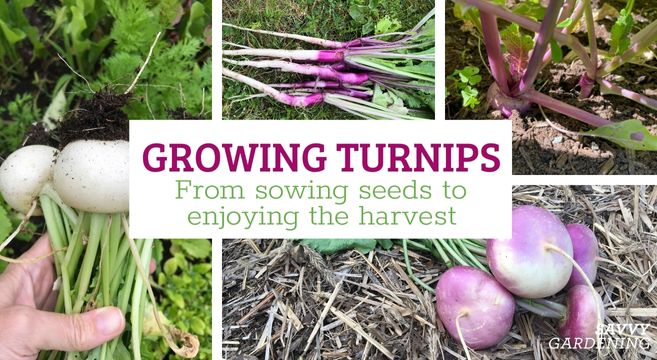This post may contain affiliate links. If you make a purchase through links on our site, we may earn a commission.
A packet seeds filled with a new variety of Hakurei turnips changed my summer barbecues forever. Okay, maybe that’s a bit of an exaggeration. But if you’ve ever roasted turnips on the grill, you know what a treat they are. These flavorful, crunchy veggies are quick and easy to grow. In this article, I’m going to share tips on growing turnips and how to know when to harvest them.
Turnips (Brassica rapa subsp. rapa) are among those early-spring crops that you can sow in cool weather, before the heat lovers, like tomatoes and peppers go in. They are quick growing, so you’ll likely have a harvest by late spring.
You can plant turnip seeds about two to three weeks before your last frost date. Stagger your sowing and you’ll extend your harvest period so you can enjoy them for longer.
Come summer, once you’ve pulled other crops, turnips are a great option for succession planting. I often plant a fall crop to enjoy turnip harvests well into autumn—if I think ahead in the late summer (usually around August).

Another bonus? Turnip leaves are also edible, so you can harvest turnip greens for salads and stir fries.
What’s the difference between a turnip and a rutabaga?
Turnips are often called summer turnips to differentiate them from the rutabaga. They usually have white flesh when you cut them open. Rutabagas, on the other hand, have a more yellow flesh on the inside and are generally bigger in size. They are sometimes referred to as winter turnips. They’re both members of the Brassica family (along with cauliflower, broccoli, Brussels sprouts, cabbage, etc.) and are similar in flavor.

Growing turnips from seed
Turnips are one of those veggies that you don’t look for at the garden center as a seedling. You grow them from tiny little seeds in an area of the garden that gets full sun because turnip roots do not like to be disturbed.
I’ll amend the soil in my raised beds with compost (usually manure) in the fall so that they’re ready for early-spring crops, like turnips. You can also wait until spring to amend your soil. Make sure the soil where you’re going to plant your root vegetable is loose and well-draining.
To sow seeds, simply make a shallow furrow in the soil that’s about ¼ to ½ an inch deep (½ to 1 cm). You can scatter the seeds from your packet or you can try to be more intentional with your sowing. This takes more patience, but saves seeds. Space seeds about four to six inches (10 to 15 cm) apart. Gently move the soil from the edges of your furrow overtop of the seeds to cover.

If you’re planting multiple rows of turnip seeds, place them about 12 inches (30 cm) apart.
When the turnip seedlings are about four inches (10 cm) high, thin them out so they’re about four to six inches (10 to 15 cm) apart. They need this space to grow. You can pluck out the seedlings with your fingers or snip them at soil level with herb scissors. Time your thinning with a salad and you can add the microgreens you sacrifice to your meal!
How do you know when to harvest turnips?
Water your turnip rows lightly until the seeds have germinated (about one to two weeks) so you don’t wash those tiny seeds away. Be sure to water consistently to encourage good root development.

Turnip leaves can be harvested (snip them a couple of inches above the base of the plant) while the turnips are still small in size.
What’s great about turnips compared to some other root vegetables is they push themselves out of the soil, so you can see how big they are before you pull them out. The seed packet will indicate the days to maturity and diameter when full grown. Small turnips can be harvested as soon as five weeks after planting.
With a fall harvest, turnips can take a couple of light frosts before you pull them. In fact, they may even taste sweeter.

Potential pests when growing turnips
As members of the Brassica family, turnips can be targeted by cabbage moths, though I find the moths gravitate towards the kale and broccoli in my garden first. I keep cabbage moths away with row cover hoops and floating row cover.
Some years, I see more damage done to the turnip leaves by flea beetles. Aphids also enjoy the leaves. And root maggots can afflict your turnips from under the soil. Try to rotate crops to another garden or area of the garden if your plants have been affected by pests.
Companion plants can be used as trap crops to lure certain pests away. Chinese mustard greens, for example, attract flea beetles. And plants like chamomile, dill, and sage, can interfere with the egg-laying habits of pests, like cabbage worms. Jessica explains this well (along with numerous other options) in her book Plant Partners.
Other companion plants can be beneficial when growing turnips. Beans and peas, for example, add nitrogen to the soil, acting as a natural, high-nitrogen fertilizer.




Leave a Reply